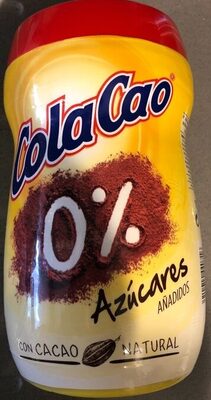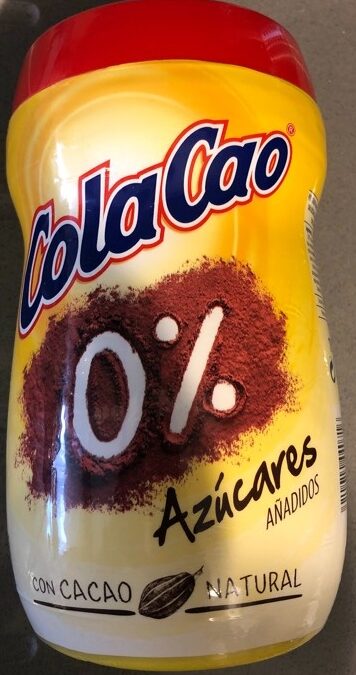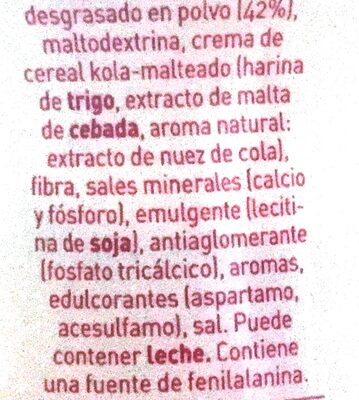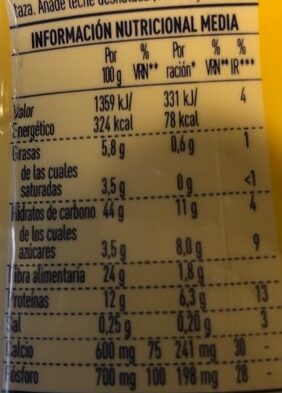Help us make food transparency the norm!
As a non-profit organization, we depend on your donations to continue informing consumers around the world about what they eat.
The food revolution starts with you!
Cola Cao 0% - 750 g
Cola Cao 0% - 750 g
This product page is not complete. You can help to complete it by editing it and adding more data from the photos we have, or by taking more photos using the app for Android or iPhone/iPad. Thank you!
×
Barra-kodea: 8410014440716 (EAN / EAN-13)
Kopurua: 750 g
Markak: Cola Cao
Kategoriak: en:Beverages, en:Breakfasts, en:Cocoa and its products, en:Cocoa and chocolate powders, en:Instant beverages, en:Chocolate powders
Etiketak, ziurtagiriak, sariak:
en:Sustainable farming, en:Contains a source of phenylalanine, No added sugar, UTZ Certified
Matching with your preferences
Health
Osagaiak
-
20 ingredients
Gaztelania: Cacao desgrasado en polvo (42%), maltodextrina, crema de cereal kota-malteado (harina de trigo, extracto de malta de cebada, aroma natural. extracto de nuez de cola), fibra, sales minerales (calcio y fosforo), emulgente (lecitina de soja), antiaglomerante (fosfato tricalcico), aromas, edulcorantes (aspartamo, acesulfamo), salAlergenoak: en:Gluten, en:SoybeansAztarnak: en:Milk
Food processing
-
Ultra processed foods
Elements that indicate the product is in the 4 - Ultra prozesatutako elikagaiak eta edariak group:
- Gehigarria: E322
- Gehigarria: E950
- Gehigarria: E951
- Osagaia: Emulsifier
- Osagaia: Flavouring
- Osagaia: Maltodextrin
- Osagaia: Sweetener
Food products are classified into 4 groups according to their degree of processing:
- Prozesatu gabeko edo ahalik eta gutxien prozesatutako elikagaiak
- Sukaldaritzako osagaiak prozesatu
- Prozesatutako jakiak
- Ultra processed foods
The determination of the group is based on the category of the product and on the ingredients it contains.
Gehigarriak
-
E322
Lecithin: Lecithin -UK: , US: , from the Greek lekithos, "egg yolk"- is a generic term to designate any group of yellow-brownish fatty substances occurring in animal and plant tissues, which are amphiphilic – they attract both water and fatty substances -and so are both hydrophilic and lipophilic-, and are used for smoothing food textures, dissolving powders -emulsifying-, homogenizing liquid mixtures, and repelling sticking materials.Lecithins are mixtures of glycerophospholipids including phosphatidylcholine, phosphatidylethanolamine, phosphatidylinositol, phosphatidylserine, and phosphatidic acid.Lecithin was first isolated in 1845 by the French chemist and pharmacist Theodore Gobley. In 1850, he named the phosphatidylcholine lécithine. Gobley originally isolated lecithin from egg yolk—λέκιθος lekithos is "egg yolk" in Ancient Greek—and established the complete chemical formula of phosphatidylcholine in 1874; in between, he had demonstrated the presence of lecithin in a variety of biological matters, including venous blood, in human lungs, bile, human brain tissue, fish eggs, fish roe, and chicken and sheep brain. Lecithin can easily be extracted chemically using solvents such as hexane, ethanol, acetone, petroleum ether, benzene, etc., or extraction can be done mechanically. It is usually available from sources such as soybeans, eggs, milk, marine sources, rapeseed, cottonseed, and sunflower. It has low solubility in water, but is an excellent emulsifier. In aqueous solution, its phospholipids can form either liposomes, bilayer sheets, micelles, or lamellar structures, depending on hydration and temperature. This results in a type of surfactant that usually is classified as amphipathic. Lecithin is sold as a food additive and dietary supplement. In cooking, it is sometimes used as an emulsifier and to prevent sticking, for example in nonstick cooking spray.Source: Wikipedia (Ingeles)
-
E322i - Lezitina
Lecithin: Lecithin -UK: , US: , from the Greek lekithos, "egg yolk"- is a generic term to designate any group of yellow-brownish fatty substances occurring in animal and plant tissues, which are amphiphilic – they attract both water and fatty substances -and so are both hydrophilic and lipophilic-, and are used for smoothing food textures, dissolving powders -emulsifying-, homogenizing liquid mixtures, and repelling sticking materials.Lecithins are mixtures of glycerophospholipids including phosphatidylcholine, phosphatidylethanolamine, phosphatidylinositol, phosphatidylserine, and phosphatidic acid.Lecithin was first isolated in 1845 by the French chemist and pharmacist Theodore Gobley. In 1850, he named the phosphatidylcholine lécithine. Gobley originally isolated lecithin from egg yolk—λέκιθος lekithos is "egg yolk" in Ancient Greek—and established the complete chemical formula of phosphatidylcholine in 1874; in between, he had demonstrated the presence of lecithin in a variety of biological matters, including venous blood, in human lungs, bile, human brain tissue, fish eggs, fish roe, and chicken and sheep brain. Lecithin can easily be extracted chemically using solvents such as hexane, ethanol, acetone, petroleum ether, benzene, etc., or extraction can be done mechanically. It is usually available from sources such as soybeans, eggs, milk, marine sources, rapeseed, cottonseed, and sunflower. It has low solubility in water, but is an excellent emulsifier. In aqueous solution, its phospholipids can form either liposomes, bilayer sheets, micelles, or lamellar structures, depending on hydration and temperature. This results in a type of surfactant that usually is classified as amphipathic. Lecithin is sold as a food additive and dietary supplement. In cooking, it is sometimes used as an emulsifier and to prevent sticking, for example in nonstick cooking spray.Source: Wikipedia (Ingeles)
-
E341
Calcium phosphate: Calcium phosphate is a family of materials and minerals containing calcium ions -Ca2+- together with inorganic phosphate anions. Some so-called calcium phosphates contain oxide and hydroxide as well. They are white solids of nutritious value.Source: Wikipedia (Ingeles)
-
E341iii
Calcium phosphate: Calcium phosphate is a family of materials and minerals containing calcium ions -Ca2+- together with inorganic phosphate anions. Some so-called calcium phosphates contain oxide and hydroxide as well. They are white solids of nutritious value.Source: Wikipedia (Ingeles)
-
E950
Acesulfame potassium: Acesulfame potassium - AY-see-SUL-faym-, also known as acesulfame K -K is the symbol for potassium- or Ace K, is a calorie-free sugar substitute -artificial sweetener- often marketed under the trade names Sunett and Sweet One. In the European Union, it is known under the E number -additive code- E950. It was discovered accidentally in 1967 by German chemist Karl Clauss at Hoechst AG -now Nutrinova-. In chemical structure, acesulfame potassium is the potassium salt of 6-methyl-1‚2,3-oxathiazine-4-3H--one 2‚2-dioxide. It is a white crystalline powder with molecular formula C4H4KNO4S and a molecular weight of 201.24 g/mol.Source: Wikipedia (Ingeles)
-
E951
Aspartame: Aspartame -APM- is an artificial non-saccharide sweetener used as a sugar substitute in some foods and beverages. In the European Union, it is codified as E951. Aspartame is a methyl ester of the aspartic acid/phenylalanine dipeptide. A panel of experts set up by the European Food Safety Authority concluded in 2013 that aspartame is safe for human consumption at current levels of exposure. As of 2018, evidence does not support a long-term benefit for weight loss or in diabetes. Because its breakdown products include phenylalanine, people with the genetic condition phenylketonuria -PKU- must be aware of this as an additional source.It was first sold under the brand name NutraSweet. It was first made in 1965, and the patent expired in 1992. It was initially approved for use in food products by the U.S. Food and Drug Administration -FDA- in 1981. The safety of aspartame has been the subject of several political and medical controversies, United States congressional hearings, and Internet hoaxes.Source: Wikipedia (Ingeles)
Ingredients analysis
-
en:Palm oil free
No ingredients containing palm oil detected
Unrecognized ingredients: es:crema-de-cereal-kota-malteadoSome ingredients could not be recognized.
We need your help!
You can help us recognize more ingredients and better analyze the list of ingredients for this product and others:
- Edit this product page to correct spelling mistakes in the ingredients list, and/or to remove ingredients in other languages and sentences that are not related to the ingredients.
- Add new entries, synonyms or translations to our multilingual lists of ingredients, ingredient processing methods, and labels.
If you would like to help, join the #ingredients channel on our Slack discussion space and/or learn about ingredients analysis on our wiki. Thank you!
-
en:Vegan status unknown
Unrecognized ingredients: es:crema-de-cereal-kota-malteado, Zuntz, Kaltzio, en:PhosphorSome ingredients could not be recognized.
We need your help!
You can help us recognize more ingredients and better analyze the list of ingredients for this product and others:
- Edit this product page to correct spelling mistakes in the ingredients list, and/or to remove ingredients in other languages and sentences that are not related to the ingredients.
- Add new entries, synonyms or translations to our multilingual lists of ingredients, ingredient processing methods, and labels.
If you would like to help, join the #ingredients channel on our Slack discussion space and/or learn about ingredients analysis on our wiki. Thank you!
-
en:Vegetarian status unknown
Unrecognized ingredients: es:crema-de-cereal-kota-malteado, Zuntz, Kaltzio, en:PhosphorSome ingredients could not be recognized.
We need your help!
You can help us recognize more ingredients and better analyze the list of ingredients for this product and others:
- Edit this product page to correct spelling mistakes in the ingredients list, and/or to remove ingredients in other languages and sentences that are not related to the ingredients.
- Add new entries, synonyms or translations to our multilingual lists of ingredients, ingredient processing methods, and labels.
If you would like to help, join the #ingredients channel on our Slack discussion space and/or learn about ingredients analysis on our wiki. Thank you!
-
Details of the analysis of the ingredients
We need your help!
Some ingredients could not be recognized.
We need your help!
You can help us recognize more ingredients and better analyze the list of ingredients for this product and others:
- Edit this product page to correct spelling mistakes in the ingredients list, and/or to remove ingredients in other languages and sentences that are not related to the ingredients.
- Add new entries, synonyms or translations to our multilingual lists of ingredients, ingredient processing methods, and labels.
If you would like to help, join the #ingredients channel on our Slack discussion space and/or learn about ingredients analysis on our wiki. Thank you!
es: Cacao desgrasado en polvo 42%, maltodextrina, crema de cereal kota-malteado (harina de trigo, extracto de malta de cebada, aroma natural, nuez de cola), fibra, sales minerales (calcio, fosforo), emulgente (lecitina de soja), antiaglomerante (fosfato tricalcico), aromas, edulcorantes (aspartamo, acesulfamo), sal- Cacao desgrasado en polvo -> en:fat-reduced-cocoa-powder - vegan: yes - vegetarian: yes - ciqual_food_code: 18100 - percent_min: 42 - percent: 42 - percent_max: 42
- maltodextrina -> en:maltodextrin - vegan: yes - vegetarian: yes - percent_min: 6.44444444444444 - percent_max: 42
- crema de cereal kota-malteado -> es:crema-de-cereal-kota-malteado - percent_min: 2 - percent_max: 33.3333333333333
- harina de trigo -> en:wheat-flour - vegan: yes - vegetarian: yes - ciqual_proxy_food_code: 9410 - percent_min: 0.5 - percent_max: 33.3333333333333
- extracto de malta de cebada -> en:barley-malt-extract - vegan: yes - vegetarian: yes - percent_min: 0 - percent_max: 16.6666666666667
- aroma natural -> en:natural-flavouring - vegan: maybe - vegetarian: maybe - percent_min: 0 - percent_max: 11.1111111111111
- nuez de cola -> en:cola-nut - vegan: yes - vegetarian: yes - percent_min: 0 - percent_max: 8.33333333333333
- fibra -> en:fiber - percent_min: 0 - percent_max: 25
- sales minerales -> en:minerals - percent_min: 0 - percent_max: 17.1851851851852
- calcio -> en:calcium - percent_min: 0 - percent_max: 17.1851851851852
- fosforo -> en:phosphor - percent_min: 0 - percent_max: 8.59259259259259
- emulgente -> en:emulsifier - percent_min: 0 - percent_max: 12.8888888888889
- lecitina de soja -> en:soya-lecithin - vegan: yes - vegetarian: yes - ciqual_food_code: 42200 - percent_min: 0 - percent_max: 12.8888888888889
- antiaglomerante -> en:anti-caking-agent - percent_min: 0 - percent_max: 10.3111111111111
- fosfato tricalcico -> en:e341iii - vegan: yes - vegetarian: yes - percent_min: 0 - percent_max: 10.3111111111111
- aromas -> en:flavouring - vegan: maybe - vegetarian: maybe - percent_min: 0 - percent_max: 5
- edulcorantes -> en:sweetener - percent_min: 0 - percent_max: 5
- aspartamo -> en:e951 - vegan: yes - vegetarian: yes - percent_min: 0 - percent_max: 5
- acesulfamo -> en:e950 - vegan: yes - vegetarian: yes - percent_min: 0 - percent_max: 2.5
- sal -> en:salt - vegan: yes - vegetarian: yes - ciqual_food_code: 11058 - percent_min: 0 - percent_max: 0.25
-
Nutrition facts
Nutrition facts As sold
for 100 g / 100 mlCompared to: en:Chocolate powders Energia 1.359 kj
(324 kcal)+% 5 Koipe 5,8 g +% 82 Gantz-azido ase 3,5 g +% 101 Carbohydrates 44 g -% 23 Azukre 3,5 g -% 93 Fiber 24 g +% 272 Proteina 12 g +% 104 Gatz arrunt 0,25 g +% 40 Kaltzio 600 mg +% 226 Fosforo 700 mg +% 158 Fruits‚ vegetables‚ nuts and rapeseed‚ walnut and olive oils (estimate from ingredients list analysis) 2,146 % Cocoa (minimum) 42 % +% 69
Ingurumena
-
Eco-Score C - Moderate environmental impact
The Eco-Score is an experimental score that summarizes the environmental impacts of food products.→ The Eco-Score was initially developped for France and it is being extended to other European countries. The Eco-Score formula is subject to change as it is regularly improved to make it more precise and better suited to each country.Life cycle analysis
-
Average impact of products of the same category: C (Score: 54/100)
Kategoria: Instant cocoa or chocolate beverage, with sugar, ready-to-drink (reconstituted with standard semi-skimmed milk)
- PEF environmental score: 0.14 (the lower the score, the lower the impact)
- including impact on climate change: 1.48 kg CO2 eq/kg of product
Stage Impact Agriculture
65.5 %Processing
5.2 %Ontziratzea
11.4 %Transportation
11.6 %Distribution
3.4 %Consumption
3.0 %
Bonuses and maluses
-
Missing origins of ingredients information
Malus: -5
⚠ ️ The origins of the ingredients of this product are not indicated.
If they are indicated on the packaging, you can modify the product sheet and add them.
If you are the manufacturer of this product, you can send us the information with our free platform for producers.
-
Missing packaging information for this product
Malus: -15
⚠ ️ The information about the packaging of this product is not filled in.⚠ ️ For a more precise calculation of the Eco-Score, you can modify the product page and add them.
If you are the manufacturer of this product, you can send us the information with our free platform for producers.
Eco-Score for this product
-
Impact for this product: C (Score: 44/100)
Produktua: Cola Cao 0% - 750 g
Life cycle analysis score: 54
Sum of bonuses and maluses: -10
Final score: 44/100
-
Carbon footprint
-
Equal to driving 0.8 km in a petrol car
148 g CO² per 100g of product
The carbon emission figure comes from ADEME's Agribalyse database, for the category: Instant cocoa or chocolate beverage, with sugar, ready-to-drink (reconstituted with standard semi-skimmed milk) (Source: ADEME Agribalyse Database)
Stage Impact Agriculture
64.8 %Processing
7.2 %Ontziratzea
12.5 %Transportation
13.6 %Distribution
1.1 %Consumption
0.7 %
Ontziratzea
-
Missing packaging information for this product
⚠ ️ The information about the packaging of this product is not filled in.Take a photo of the recycling information Take a photo of the recycling information
Transportation
-
Origins of ingredients
Missing origins of ingredients information
⚠ ️ The origins of the ingredients of this product are not indicated.
If they are indicated on the packaging, you can modify the product sheet and add them.
If you are the manufacturer of this product, you can send us the information with our free platform for producers.Add the origins of ingredients for this product Add the origins of ingredients for this product
Etiketak
Report a problem
-
Incomplete or incorrect information?
Category, labels, ingredients, allergens, nutritional information, photos etc.
If the information does not match the information on the packaging, please complete or correct it. Open Food Facts is a collaborative database, and every contribution is useful for all.
Datuen iturria
Product added on by kiliweb
Last edit of product page on by naruyoko.
Produktuaren orria -gatik editatua acuario, elcoco, hungergames, mbe, moon-rabbit, musarana, openfoodfacts-contributors, quentinbrd, roboto-app, tasja, teolemon, thaialagata, yuka.Vm80TUc3VUh2ZUlCbmZJeDQwcUtwT0IzK2NHdmNIeW5jT1U5SVE9PQ.









